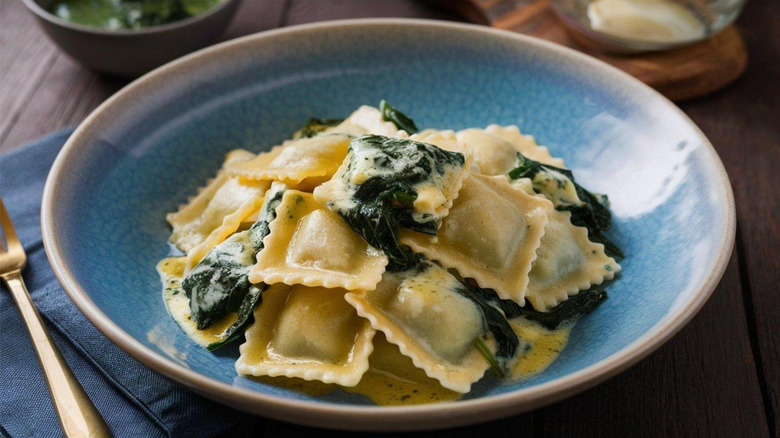Stop Wasting A Whole Ravioli To Test Its Doneness
Whether you like your ravioli stuffed with pumpkin or filled with a kaleidoscope of goodies like olives, ricotta, beef, or pork, few pastas are as difficult to resist as a plate of this stuffed pasta. And for many of us, the attempts to resist taking big bites starts even before the pasta is plated. Often, our first bites of ravioli happen before the pasta is served, because we need to test if it's even done. And this isn't just a little nibble. Most of the time, the ravioli gets completely cut in half so that you can see if it's fully cooked, but really, why cut one in half when all you really need is a bite of one of the corners?
As it turns out, this is a pretty solid and straightforward way to test your raviolis' doneness. Take one ravioli out of the water it's boiling in and put it on a small plate. Cut a small piece off of one of the corners and try it. If it tastes like partially cooked flour or paste, the ravioli needs to go back into the water.
Cook the test ravioli (and all the others) until it's at least al dente. Aside from a texture perspective, there is a safety consideration for this. Most raviolis contain eggs in their ingredients list, so you want to cook them long enough to ensure that you're not eating raw eggs, basically. They're ready to serve when they reach this level of doneness.
Cooking time required for ravioli
Obviously, you don't want to pull a test ravioli out of the water way too early. You'll only need to cut off a test corner as the pasta is getting close to being done. As a general rule, most fresh ravioli requires only four or five minutes of cooking time. Frozen ravioli takes about three minutes, depending on the level of doneness you desire.
Additionally, you usually don't need to watch the time like a hawk, because the raviolis themselves will tip you off as they near their final minutes of cooking time. Most uncooked raviolis sink to the bottom of the pot, because they weigh more than the hot water. As they cook, they'll float to the surface, indicating that dinner's close to being ready. As an aside, this is one of the chief reasons why you should avoid filling the pot to the gills with raviolis. The stuffed pasta pockets expand as they cook and will begin to crowd one another as they start to float, often sticking to their neighbors in the process.
Once they start to float, the raviolis will continue to expand, eventually overcooking. After a few minutes, they'll bloat like a puffer fish washed up on the beach, and will be about as appetizing to eat. So fish them out of the pan while they're still skinny to ensure that the pasta is edible and ready for a little marinara sauce or flavored compound butter. And when that time comes, you won't need to settle for just a bite of the corner — you can eat the whole thing.

